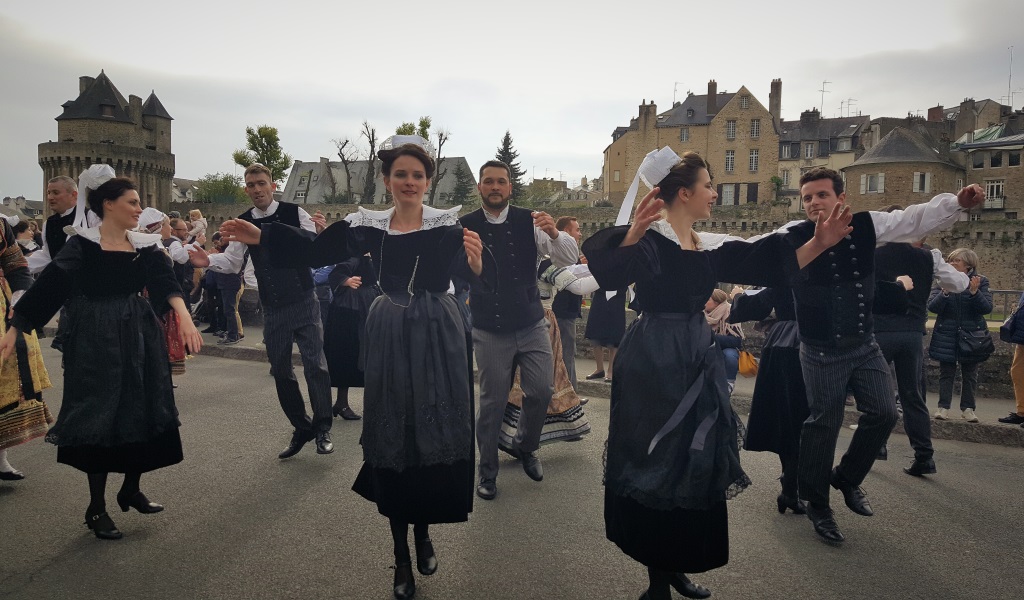
April 2 – 30, 2019 (Spring)
Greeting: Bonjour
Gratitude: Merci
Currency: Euro (€)
Visa: Schengen
Cost of living: Medium
In a far corner of northwestern France, the medieval town of Vannes seemed an ideal place to welcome the spring. It’s a popular destination thanks to its intact city walls, and also serves as a gateway to the Gulf of Morbihan. But it’s by no means a tourist trap. Vannes punches above its weight in terms of shops and amenities, yet still manages to feel small, friendly, and welcoming. We had the narrow alleys of the Old Town to ourselves more often than not. Things really only picked up on market days, which were easily worth braving the crowds. And if it ever got to be too much, we could simply walk down to the shoreline paths and find ourselves surrounded by rabbits and pastures✨ rather than people. We did that often.
Usually Western Europe falls outside our budget, except for very intentional and calculated splurges. But by taking advantage of the off-season, we managed to line up two surprisingly affordable months in the world’s most touristed country. We could sautée fresh mussels and toast French wine at (relative) bargain rates, which made Brittany a fast favorite in our books.
Where we stayed

We stumbled on Vannes in much the same way we discovered Gozo – by setting our filters on Airbnb and panning around the map after our first choice didn’t pan out. The apartment we found checked all the boxes and sat just on the edge of a gorgeous✨ Old Town. Oh, and the off-peak price was on par with some of our all-time great deals. What more could we ask for?
Our host met us at the train station after our very long travel day and drove us to the rental. The building was from the late 1800s, with a narrow staircase leading to our second-from-the-top floor unit. The space was long and narrow, with windows toward the front (street✨) and back (inner courtyard). We also had a great view of the cathedral✨ and nearby Saint-Patern✨, and stone buildings with slate roofs rolled off in the distance✨.

A kitchen and living room✨, a small bathroom with a washing machine, and a bedroom with a desk were the sum total of our space. The kitchen, really just a corner in the living room, managed to squeeze in a dishwasher, small fridge, and microwave, but lacked an oven. Our neighborhood✨ was a popular weekend party spot, but luckily the din at street level was minimal – just a few midnight shouting matches here and there. A few minutes’ walk got us to the medieval gates✨ or the train station. Supermarkets were further away from the center, but still reachable on foot.
All in all, it would have been perfect, save for one small detail. Our neighbors. Most understood that the old structure’s thin walls carried sound like a tin can phone. The guy on the other side of our bedroom wall did not. He’d come in at all hours – mid-afternoon or 3 am – slamming doors and shouting into his phone. For two jet-lagged travelers with a low tolerance for noise, it was basically torture.
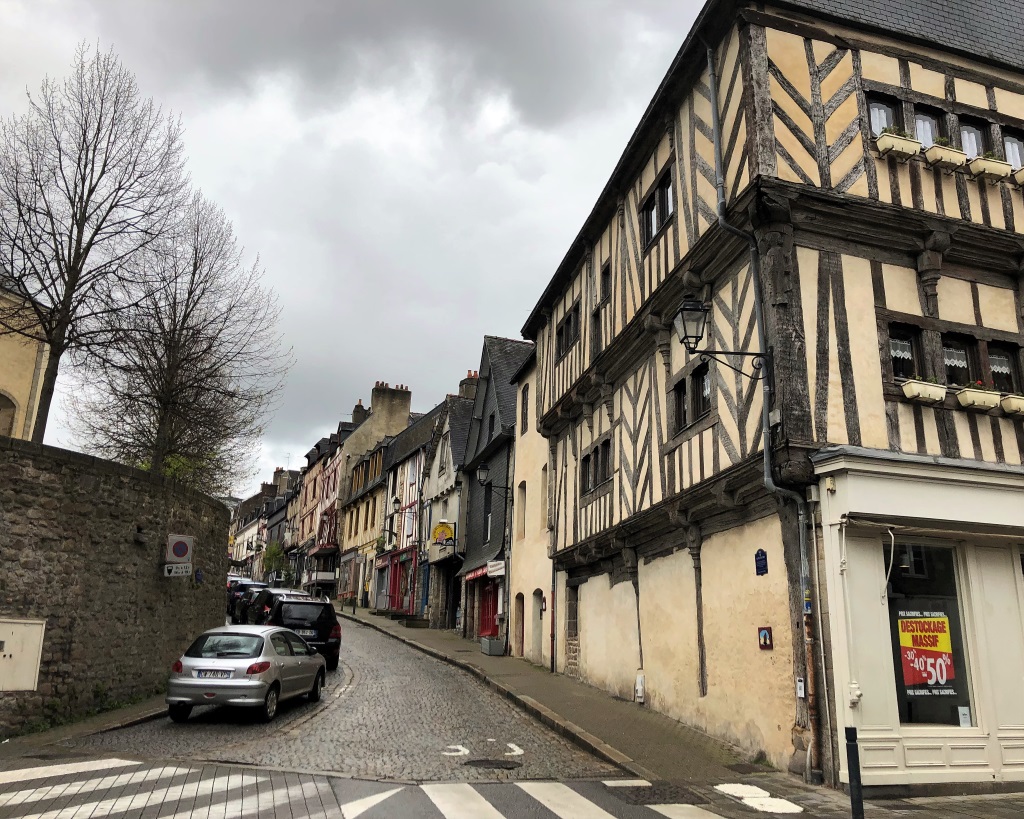
What we did

We spent most of our time in Vannes enjoying the best parts of the city: the waterfront outside of it and the Old Town that made up its heart. The 2000-ish year old city has long been tied to the sea✨. A broad river delta inlet to the sheltered waters of the Gulf of Morbihan provided residents safe harbor and a wealth of seafood. For hundreds of years it was home to the Dukes of Brittany and outlasted several sieges. The thick walls✨ and towers defended the charming structures✨, narrow avenues✨ and precious✨ places of worship then, and are now a celebrated tourist✨ attraction. A small portion of the ramparts are accessible and provide a nice view of the surroundings. A number of very French-looking government buildings✨ and manors✨ round out the historic core. Vannes also serves as a gateway to the small islands that decorate the gulf, many advertised as great day trip destinations complete with direct ferry service. Twice each week the downtown✨ became a sprawling street market with cheeses and crêpes, fresh vegetables and seafood, clothing, accessories, and other goodies.

Our visit coincided with the National Breton Dance Championship. Vannes held the first round of the three round championship↗ in mid-April, and dozens of dance groups took over multiple stages at the Palace of Arts✨. Performances reflected the Celtic heritage of the Brittany region. The traditional outfits✨ and women’s lace headdresses were nearly more impressive than the performances✨. Each village had a traditional headdress✨, or coiffe. It evolved to become a signature of sorts, revealing where the wearer was from and their status. Each coiffe needs to be thoroughly starched to keep its (sometimes fantastical) shape, hence the baskets of umbrellas that came with each group. At the end of the day, a parade of groups danced✨ and sang their way from the Palace of Arts to the town walls✨.

The most widely-known site in the region is Mont-Saint-Michel (called “Mount Saint Michael at the Peril of the Sea” in the Middle Ages, an agonizingly poetic moniker). The defensible rock spire on which it rests grows even more unassailable when rising tides turn it into an island. Understandably, this made it an ideal site for strategic fortification✨ since ancient times. We found it a worthwhile (if long) day-trip destination from Vannes. With no direct bus, we had to transfer through Rennes✨. We arrived at mid-day, two hours after high tide, and witnessed the staggering expanse✨ of the growing tideflats and powerful eddies created by the retreating water.
The road to the island is an easy walk✨, and we were glad to avoid the overstuffed✨ buses. With each step we could watch it grow from an otherworldly mirage✨ in the distance to a towering monument✨ overhead. Its popularity✨ is well-deserved. But that didn’t make the crowded streets✨ any less stifling. We bounded up the nearest alley we could, and discovered that, much like Dubrovnik, the crowds drop off exponentially with altitude✨. Other than shop and eat, there isn’t a whole lot to do on the Mont save for visiting the Abbey✨. Since we had all day, we spent part of it wandering through the guarded✨ cloisters, church✨, and vaulted rooms✨ below. The monastery fell into disuse during the French Revolution and then became a prison✨ before being restored. The interiors are sparse✨, mainly bare stone✨. Still, the magnitude and beauty of the place is simply surreal. We ended the day sighing over the breathtaking views✨, then giggling at the ant-like clusters✨ of tourists plodding through the muck below. Truly a regal end to a remarkable day.

The second best way to escape the city is to walk the waterfront paths in either direction✨ from Vannes. Our favorite route took us along the narrow channel✨ that cuts from the city gate to the waterfront, past moored boats✨ and a few popular haunts and hangouts, to a well-groomed trail✨ that hugs the eastern shore. We passed fields of grazing cattle✨ (and their bunny companions), beautiful country cabins✨, family-friendly beaches and mudflats✨ that only appeared at low tide. As at Mont-Saint-Michel, tides here have a huge range, sometimes revealing acres of mud and shellfish, and other days water submerged everything up to (and occasionally on to✨) the path. There were always people out enjoying the bucolic✨ stretches, but it was never a challenge to find space on the beach or an empty bench overlooking the water.

Food & Drink

Vannes was one of the very few places outside Seattle with seafood that lived up to our expectations. The twice-weekly street market✨ and the Halle aux Poissons served up both fresh local seafood and imported goodies from further afield. We dined on crab✨, clams, mussels, and tuna✨. The local crab was much thicker-shelled than the delicate Dungeness we had a few months ago, and we didn’t have any crab crackers. We fought fork and nail to get the precious meat out, though what we did salvage was quite tasty. Much easier to work with were the abundant mussels and clams. Our favorite preparation for them was to simply sautée in white wine and toss in pasta✨. The first time we bought them uncleaned, but the cost savings was hardly worth the extra work. We didn’t make that mistake again.

Other local specialties were equally delicious. Breton crêpes are made with buckwheat (blé noir), so they’re darker brown in color and taste nuttier. Butter cookies✨ – plain, salted, or flavored with caramel – are a common and tasty snack. A wonderful local bakery Maison Le Brun provided peerless baguettes✨ for less than €1, and a butter-sugar-bomb kouign-amann✨. Another bakery by the Halles des Lices, François, filled the streets with such tantalizing scents that couldn’t pass up an apple and custard pastry. But there were also some misses. We tried tarte a l’andouillette from a quiche vendor on our first day in town; it was not to our taste, and might have made us queasy.
Being in France we also tried more broadly typical French foods. Macarons appear in every bakery and grocery, but are a relatively expensive treat. One variety pack was plenty. Kevin made coq canard au vin (duck with wine) for his birthday, and it was rich and wonderful. As a matter of fact, duck shows up in all forms, from foie gras (much cheaper than in Québec) to smoked slices to cuts and entire birds. Duck is kind of an obsession for us, so France’s shared love made us feel right at home. Veal was also much more common than we were used to. And we found entire storefronts dedicated to meaty spreads and dips. Delectable fish and crab rillettes and pork, duck, or veal terrines made for sumptuous snaking✨ during Game of Thrones (and softened the blow a bit at its disappointing decline in quality). One spread billed as “tomato caviar” was practically identical to our beloved konserva from Malta.
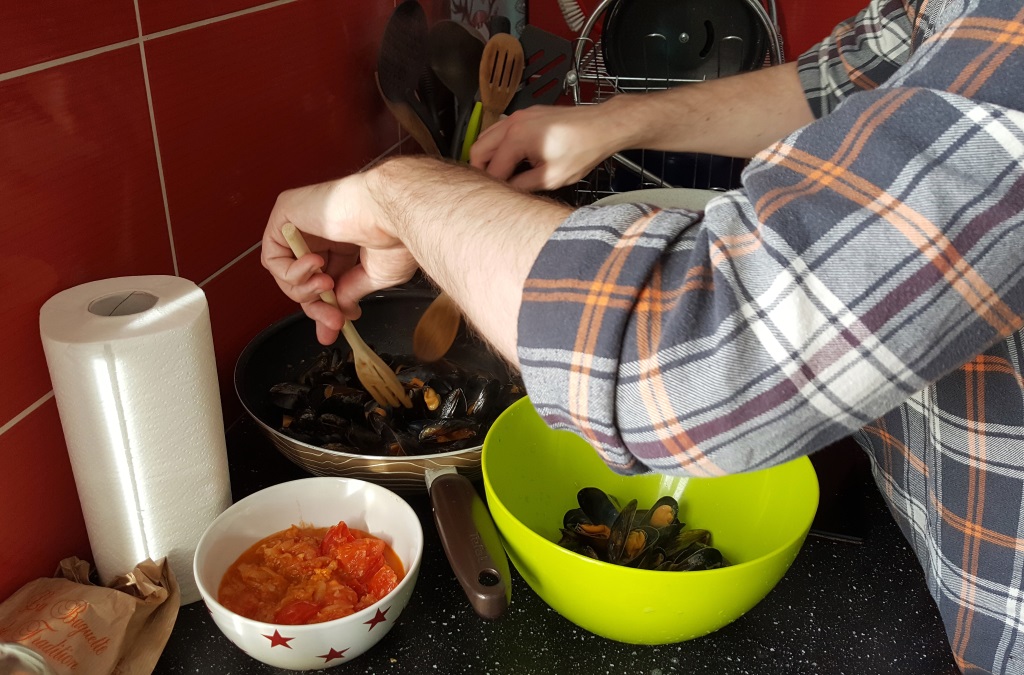
While we purchased fresh ingredients✨ from the markets, Halles des Lices✨ and Halle aux Poissons, we regularly trekked to Monoprix, Lidl, Intermarché, or Carrefour✨ for staples. Lidl once again had their lovely pans of tiramisu. And with Easter falling during our stay, Easter candies were a must. In addition to the standard rabbits and hens, we spotted pandas, lambs, and sea creatures✨. For some reason, this corner of Europe was the opposite of the rest of the continent – peanut butter was commonplace but popcorn was a rare commodity. Chip flavors were less impressive✨. The best of the good ones✨ were Lay’s Thai Spice. Dessert was a bit better, with gelaterias on the street and Nuii✨ peanut butter and maple syrup ice cream bars in supermarkets.

Living in France also meant drinking lots of French wine✨. Like Portugal, having a glass of vin rouge with supper is basically a given. Our budget being what it is, we mostly stuck to the cheaper bottles (under €8). That didn’t mean we sacrificed quality, though. There was plenty of delicious options from Burgundy or the Rhone region, even Alsace. The white we used to seared seafood was less than €3 and was as good for drinking as cooking.
Traditionally, the local drink in Bretagne is apple cider✨. The juice is pressed along with the leaves and stems, then barreled or bottled and aged for several months. This means the flavor is more wine-like than the hard ciders in the British tradition we’re used to. These days it’s fallen out of fashion somewhat, and is something of an “old man” drink. But we enjoyed the several we tried, with flavors ranging from skunky to crisp and sweet. Beer was less remarkable. Not great, not terrible. Most intriguing were the regional craft options✨, some even made with buckwheat✨ – just like the crêpes.

Getting around

Our Norwegian Air flight took us direct from Denver to Paris. The low-cost carrier had no frills, but our one-way flight totaled just $500 for both of our tickets plus checked bags. We arrived at Charles de Gaulle Airport in the early afternoon and left from the airport on a TGV train for Rennes about 5 hours later. In Rennes, we transferred from the higher-speed line to a more local train for the final leg to Vannes. It was very long day of travel, but the smooth transit connections in France made the 500km, cross-country journey easier than we hoped.
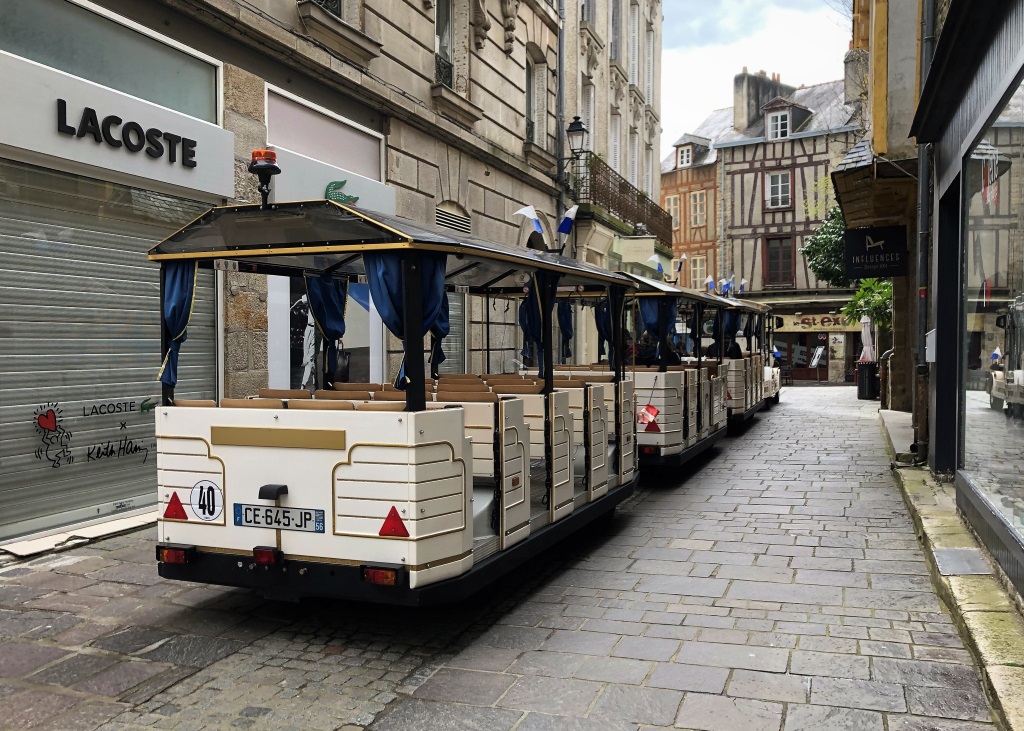
Naturally Uber↗ was available, along with Uber eats. We didn’t use it, preferring to walk everywhere. The one time we got caught in rain on the way back from the Carrefour Shopping Center, we spent €1.50 each on a local bus ticket back to the center. The local bus lines run frequently and tickets are available from the drivers, who can provide change if needed.
For our day trip to Mont-Saint-Michel✨, we opted for buses over trains. The first leg, from Vannes to Rennes✨, was well-served by FlixBus, and we managed to find seats at good times for just €1. After a few hours’ wait (the connection from Rennes to MSM runs much less frequently and is optimized for tourists coming from Paris, not Vannes), we hopped on an SNCF-run bus for the rest of the journey. This leg cost substantially more, €15 per person each way. The return featured another long wait, made longer by our FlixBus getting delayed on its way from Paris. But fitting the whole trip into a single day staved us a boatload on overpriced accommodations on or around the rock itself.
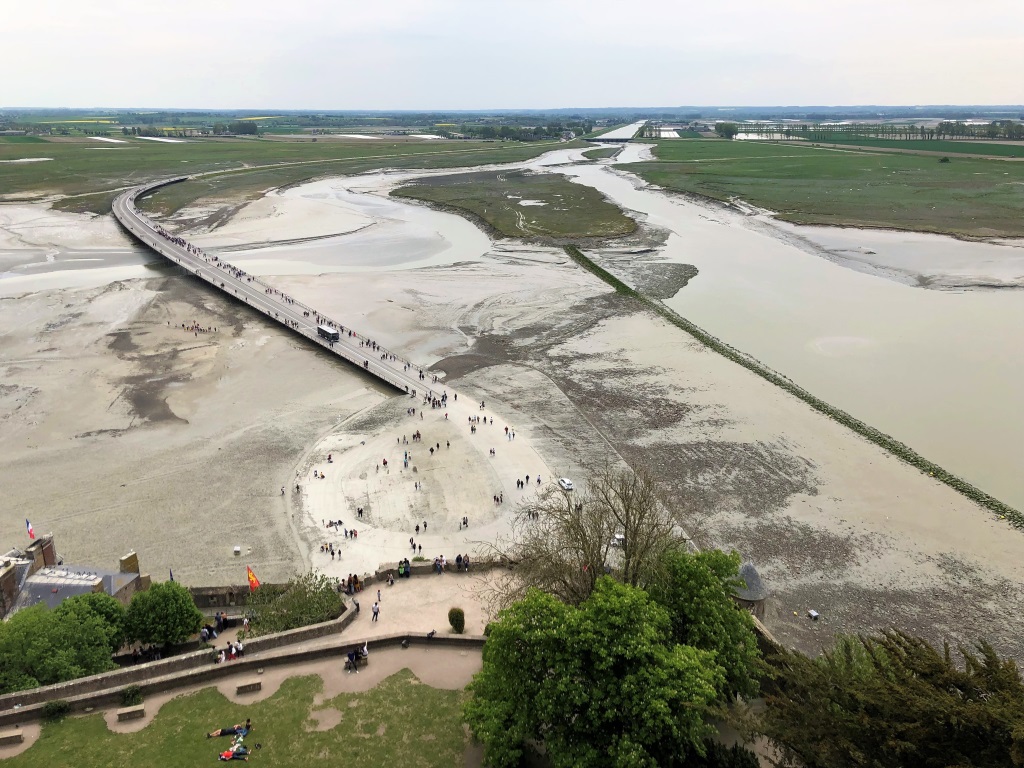
Stuff of interest
Our SIMs↗ came from SFR. We both lucked out when we stumbled on SFR’s Carte Connect at CDG, and again at the Vannes train station. This SIM costs €15 and comes loaded with 2 gigs of data plus talk and text, valid for 30 days. Both times, it was a Relay shop that carried it. We had to activate the SIMs ourselves, and on our Android it never did register quite right (though it still functioned just fine).
Danielle broke a retainer wire off a tooth right before Easter and had a hard time finding an orthodontist to repair it. She settled for a packet of dental wax from a local pharmacy to cover the wire until she could get it fixed in Brest.
Basically every shop closes on Sunday, even the large groceries and malls. Many smaller stores and restaurants shutter for a couple of hours each day around lunchtime or in the middle of the afternoon.

We’ve mentioned the local tides a few times already, but they really do have massive swings✨. Some places have variances of 40 feet or more, meaning they sweep in and out with incredible ferocity and speed✨.
People in Brittany traditionally spoke Breton, a Celtic language related closely to Cornish and distantly to Welsh. Though French is of course the language of daily life, the endangered local dialect is bouncing back somewhat. All official signage is bilingual, and the number of children being taught the language in schools is rising steadily.

What we learned
Once more, we were reminded nothing is permanent, even things that seem too venerable and important ever to change. During our stay, Notre Dame in Paris burned – the only thing on the news for two full days. It will be repaired, of course. Eventually. But we were grateful we got to visit it✨ years ago on our first trip to Europe.
Travel isn’t just a place, but a time. Vilnius changed noticeably in just one year, Seattle after three was unrecognizable. Just another reason to keep traveling – who knows what we might be the last to see? Whether its human achievements (thinking back to another fire that ravaged Brazil’s National Museum) or the rapidly changing face of the planet under climate change, the world as we know it is a fragile, temporary thing.







